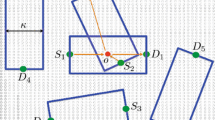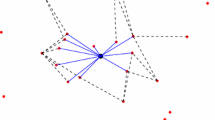Abstract
We consider an infinite tandem network in which every node is capable of hearing its neighbors up to a given distancen. At any moment of time every node may contain in the top of its queue a message destined to one of its neighbors. This network can be used as a model for a microwave or optic link with many users. For small and largen we investigate the maximal selection of nodes in the network, for which their transmissions are collision-free. For a large hearing range we show that the upper bound on the maximal selection, which is found herein, is asymptotically achievable. For small hearing ranges we show that a greedy selection is better but not asymptotically optimal. We also specify a sequence of upper bounds which converge to the maximal throughput.
Similar content being viewed by others
References
Even, S., Goldreich, O., Moran, S., and Tong, P., On the NP completeness of Some Network Testing Problems,Networks, Vol. 14, pp. 1–24, 1984.
Jaffe, J. M., and Rosberg, Z., Dynamic Behavior of Tandem Packet Radio Network, Technical Report 88.159, IBM Israel Scientific Center, May 1985.
Jaffe, J. M., and Rosberg, Z., Maximal Throughput in a Tandem Multihop Network,Performance Evaluation, Vol. 9, pp. 55–68, 1988.
Nelson, R., Channel Access Protocols for Multi-hop Broadcast Packet Radio Networks, Ph.D. thesis, Computer Science Department, UCLA, Los Angeles, CA, 1982.
Nelson, R., and Kleinrock, L., Mean Message Delay in Multi-hop Packet Radio Networks Using Spatial TDMA,Proc. ICC, pp. lc.4.1–lc.4.4, 1982.
Ross, M. S.,Applied Probability Models with Optimization Application, Holden-Day, San Francisco, CA, 1970.
Sidi, M., Tandem Packet-Radio Queuing Networks,IEEE Trans. Comm., Vol. 35, No. 2, pp. 246–248, 1988.
Silvester, J. A., and Kleinrock, L., On the Capacity of Multi-hop Slotted ALOHA Networks with Regular Structure,IEEE Trans. Comm., Vol. 31, No. 8, pp. 974–984, 1983.
Tobagi, A. F., Multiaccess Link Control, inComputer Network Architecture and Protocols, edited by P. E. Green, pp. 145–189, Plenum, New York, 1982.
Yemini, Y., On Channel Sharing in Discrete Time Packet Switched Multi-Access Broadcast Communication, Ph.D. thesis, Computer Science Department, UCLA, Los Angeles, CA, 1979.
Author information
Authors and Affiliations
Additional information
Communicated by Israel Cidon and Inder S. Gopal.
This research was done while J. M. Jaffe was on leave at the IBM Israel Scientific Center.
Rights and permissions
About this article
Cite this article
Jaffe, J.M., Rosberg, Z. Maximal selection in tandem networks with symmetric hearing range. Algorithmica 4, 343–364 (1989). https://doi.org/10.1007/BF01553896
Received:
Revised:
Issue Date:
DOI: https://doi.org/10.1007/BF01553896




